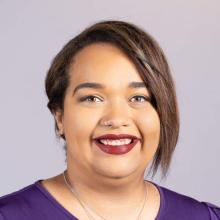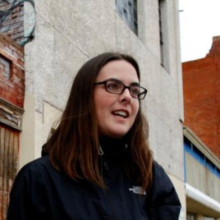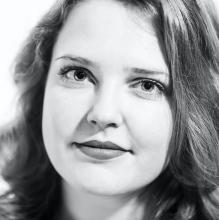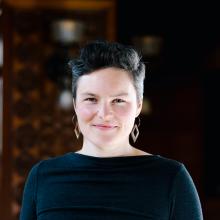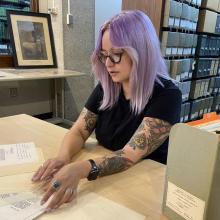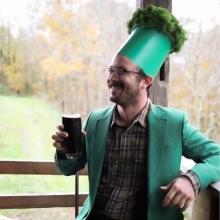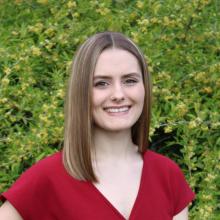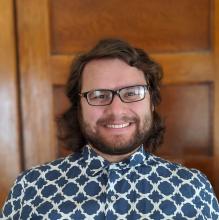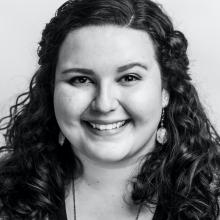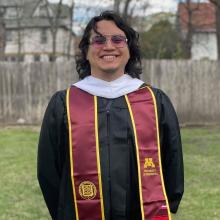Alumni of the Heritage Studies & Public History (HSPH) graduate degree apply the skills gained from hands-on courses and internship experiences in the program to become preservationists, educators, cultural liaisons, historians, project directors, and more at museums and organizations across the country. Learn more about our alumni, what drew them to the program, and how HSPH has since shaped their professional journeys.
Meet Our Alumni
Keyah Adams
Mead & Hunt, Cultural Resource Specialist
HPSH Track: Archaeological Heritage
Capstone: "Examining Environmental and Land Use Impacts: A Risk Assessment of Camp Cold Water"
Why did you choose HSPH?
I had an interest in combining heritage, museums, and Anthropology and it seemed to be a good fit. As a biracial female in a field that is predominantly female but lacking in BIPOC individuals, I saw that this program also focused on getting minorities into the preservation fields. I was also intrigued that the program was hands-on and helped you get real-world experience so that you're ready for post-graduate life.
More about Keyah
What do you do in your current position?
I was hired to help with a project digitizing historical architectural inventories for the State of Minnesota. I now help with writing historical contexts and perform fieldwork for a variety of projects. I also serve on our Underrepresented Groups Initiative team to find out how we can diversify our projects to better serve other communities and diversify the field. I also consult on some projects that have an archaeological or tribal component since I am the only archaeologist in an architectural office.
In what ways did the HSPH program prepare you for your current position?
With the hands-on capstone projects, I made connections with people in state agencies through my partners. Our blog posts that we wrote as assignments actually prepared me to write a blog post for my job through our Underrepresented Groups Initiative for Native American Heritage Month. Being in the Archaeological track, I had freedom to take classes about cultural resources (architecture), historical archaeology, and Native American archaeology, which helped me become well versed in different aspects of what I currently do with my job as well as the freelance research I do.
Elisabeth DeGrenier
Wyoming State Museum, Supervisor of Exhibits and Programs
HPSH Track: Historic Preservation
Capstone: "360 Sensory Tours"
Why did you choose HSPH?
HSPH’s premise of using history to address social injustices and inequities sparked something in me. I already had museum experience, but I stumbled around trying to incorporate previously ignored voices into my projects. I was drawn to the idea of directly applying these concepts from my classes into my internships and various projects. HSPH is unique in its ability to reveal inequities and then give its students the opportunities to actually do something about it. This process absolutely elevated me as a public-facing historian, educator, and curator. When I catch up with folks from my cohort, we all express how original this program is. It has prepared each of us to revolutionize where our institutions are and where they will go.
More about Elisabeth
What do you do in your current position?
I currently manage all exhibits and programs, including four staff members, at the Wyoming State Museum in Cheyenne. I oversee the design, layout, interpretation, and creation of all digital, physical, and traveling exhibitions. So far, this has included exhibits of all scales. Currently, I am working on a significant exhibit renovation, a Capitol art showcase, a digital photogrammetry project, a volunteer-based exhibit, and a children’s interactive space. All of these projects have included community collaboration and insight.
HSPH concepts influence each of these projects. My role provides a lot of potential to make our museum space (physically and digitally) more equitable and community-driven.
What advice would you have for prospective and current students?
Be open.
See your time in grad school as an opportunity to absorb new ways of thinking and approaches to projects. You’ll be wrong and mess up a couple of times, but the program, your collaborators, and fellow students will help you through. Having this mindset will let you get the most out of your experiences and allow you to grow personally and professionally.
Simiyha Garrison
Old Salem Museum, Education Coordinator
HPSH Track: Public History
Capstone: "For the Love of Crowns, an exhibit centered on Black hair"
Why did you choose HSPH?
When I visited Minnesota in April of 2018 it felt like home, although I had never been before. Greg Donofrio, the director of HSPH, provided an amazing two-day tour. My mentor at the time knew Kevin Murphy, a faculty member in the program, and he was as awesome as she described. Greg and Kevin went out of their way to accommodate me even before I accepted their offer.
More about Simiyha
What do you do in your current position?
I create educational resources for students K-12. I conduct research on African American and Native American influence on Moravian FoodWays in the Wachovia tract. I also meet with various stakeholders at the Old Salem Museum to discuss best inclusive practices.
In what ways did the HSPH program prepare you for your current position?
HSPH prepared me for my current position by allowing me to learn through experience and not just by the book. We were given the opportunity to conduct various internships for three semesters. Everything was community-based and hands-on so that our resumes accurately reflect what we are capable of.
Ellie Heaton
Reading and Math, Inc., Administrative Assistant
HSPH Track: Archaeological Heritage
Capstone: "Tips and Guidelines for Community-Driven Collaborations"
Why did you choose HSPH?
I saw HSPH as a one-of-a-kind program where I could prepare to continue working in the fields of archaeology and cultural resource management, but with a lens of social justice and a method of ethical collaboration. I saw that I would get access to the museum world and the public history landscape. I was excited to see the kinds of connections and intersections our different backgrounds would bring. I was also drawn to the size of the program, where I knew I would get smaller classes and get to know my peers and the program advisors well. I got great experience building relationships with organizations all over the Twin Cities that laid the groundwork for potential future employment.
Natalie Heneghan
Places Reimagined, Education Manager
HPSH Track: Historic Preservation
Capstone: "New Tools for Old Buildings: Addressing Barriers to Building Rehab in Rural Minnesota"
Why did you choose HSPH?
HSPH centers community, diversity, and culture in ways that other programs don't, or can't. I know some other master's programs in preservation are evolving to ensure their students are equipped to work across cultures or are well-versed in community engagement strategies. But HSPH was *built* on these values; they weren't added after the fact. That was an important distinction as I decided to go back to school.
More about Natalie
What do you do in your current position?
My job is to help people reuse and take good care of old buildings. I create classes that teach people maintenance, rehab, and restoration skills. My driving goal is to democratize knowledge about old buildings. I want to ensure everyone has access to the resources, tools, and skills they need in order to take care of places they love. I'm also a huge advocate for built environment sustainability, meaning I support policies and projects that keep existing building materials out of the trash and that reduce our reliance on producing new things. Preservation is inherently a sustainable practice; educating communities about salvage, material reuse, deconstruction, and improving energy efficiency is core to my work.
Kacie Lucchini Butcher
University of Wisconsin-Madison, Public History Project Director
HPSH Track: Historic Preservation/Public History
Capstone: "Owning Up: Racism and Housing in Minneapolis" [Exhibit]
Why did you choose HSPH?
I chose the program because it had the flexibility that would allow me to experiment and find my voice as a public historian. I liked that the program had many fellowship and internship opportunities that added to my resume—I think this is why I got my current position. The program and its leadership were honest in their view of the scholars they hoped we would become: radical, inventive, boundary-pushing, rule breaking. That is what I had envisioned for my work as well. The stars all aligned!
More about Kacie
What do you do in your current position?
I am currently the Director of the UW-Madison Public History Project. The Project is a multi-year Chancellor initiative to uncover and give voice to histories of racism and discrimination at the university. The Project will culminate in a physical exhibit in the fall of 2022, a digital exhibit website, a series of events and public programming, and curricular materials - all of which will encourage the campus community to reflect on the history of the university. So, as most public historians will tell you, I am a jack of all trades! Mostly it's a lot of project management but on any given day I could be presenting to classes, writing exhibit text, organizing events with student organizations, meeting with designers, managing social media accounts and the Project newsletter, building a press kit, etc. The list goes on and on!
In what ways did the HSPH program prepare you for your current position?
The HSPH program gave me the opportunity to practice my craft before working in the field. By the time I started my current position, I had already written an exhibit, worked with a design team, presented to the public, collaborated with various community partners, organized a fundraising public event, managed a communications plan/social media, helped to build a website, etc. These are all skills I learned in classes, internships, or fellowships, and skills that I use nearly every day. Without the program, I would’ve been left to learn those skills on the job (which of course I still am learning all the time at work) but I came into my job with a leg up having done this before. It was also what made me competitive on the job market. My resume was not solely academic but a list of practical experiences, projects, and collaborative partnerships from my time in the program.
Kaytlyn Lundstrom
Minnesota Indian Affairs Council, Executive Assistant
HPSH Track: Archaeological Heritage
Capstone: "Jeffers Petroglyphs, an Oral History Initiative"
Why did you choose HSPH?
There are several reasons why I chose the HSPH program! Most influential to my final decision was the HANDS ON and interdisciplinary approach that HSPH offers. When I graduated, I had two years of relevant work experience to include in my resume. Not only does this program offer students this experience through paid internships, but it is also built into each of the core classes you take from day one. Additionally, this experience is shaped by the individual student and supported by all HSPH staff and faculty. It was also really important to be in class with other professionals who had an incredibly wide range of experience and interests. I learned just as much from the experiences of my peers as I did from the course curriculum.
More about Kaytlyn
What advice would you have for prospective and current students?
My advice would be to think critically about what experiences you are looking for and what skills you would like to develop. There are seemingly infinite possibilities and flexibility in the program, which is wonderful, but can also be overwhelming. Taking the time for self-reflection on the front end can ensure you have the best experience for your unique self in the long run.
Tyler McDaniel
Kentucky Historical Society, National History Day in KY Coordinator
HPSH Track: Historic Preservation
Capstone: "35W Art Making Workshops"
In what ways did the HSPH program prepare you for your current position?
Having the ability to work on multiple community-engaged projects in class, through research assistantships, and especially through internships gave me a ton of applicable experience. Across multiple organizations, I built a broad skill set through an impressive portfolio of projects working with diverse socio-economic cultural groups. Figuring out how all of these things connect and how they have challenged me has been really great for selling myself. Working with/in a community with reciprocity and a uniquely sensitive perspective has been a major selling point.
More about Tyler
What advice would you have for prospective and current students?
Don't be afraid to advocate for yourself. Not only is HSPH a great experiential learning tool but it is also a respectful, open forum for the individual. The folks intimately involved with the HSPH program are open to listening to your needs and criticisms. An understated takeaway that I didn't realize until after I graduated was that HSPH instilled a sense of prioritizing my own well-being while establishing a healthy work-life balance. These are necessary skills not just for grad school but also in life. Since graduating, I am amazed at how many people I've noticed who don't practice these.
Laura Meier
Shakopee Mdewakanton Sioux Community (SMSC), Tribal Records Specialist
HPSH Track: Archaeological Heritage
Capstone: "Let’s Talk Collections: Bringing Minnesota Archaeology Online"
Why did you choose HSPH?
I chose the Heritage Studies and Public History program because it aligned with my values and provided a nurturing environment for its students. From the beginning, I was drawn to its dedication to diversity and inclusion by offering an accessible and affordable educational experience and encouraging its students to engage with underrepresented histories through an interdisciplinary lens. Additionally, its attention to social justice and community engagement, and its being close to home, assured me that I could engage with stories that matter to me and that matter to the broader community.
More about Laura
What do you do in your current position?
I work for the Shakopee Mdewakanton Sioux Community (SMSC), a federally recognized, sovereign tribal nation located southwest of Minneapolis/St. Paul. As the Tribal Records Specialist, I support the Tribal Records Department in its mission to steward information related to the creation, operation, and success of the SMSC. Following the principles of information governance, we preserve and provide access to this information in order to protect the past, present, and future interests of the Community. On any given day, you can find me digitizing documents, fulfilling information requests, cataloging archival records, or tackling any other project that comes our way.
In what ways did the HSPH program prepare you for your current position?
The HSPH program provided the practical experiences, perspectives, and connections necessary for my current position. Between the (paid) internships and fellowships in areas of records management and digital collections management, especially, I was able to harness the necessary hands-on experience fundamental to my day-to-day work. Likewise, through group projects with my cohort, and partnerships with diverse communities throughout Minnesota, I further developed my communication and interpersonal skills that are at the heart of any collaborative project. In fact, through my master’s capstone project, I was also able to make my first connection with the Shakopee Mdewakanton Sioux Community, where I continue to learn and grow every day.
Jacob Noble
Wapsi Valley Archaeology, Project Historian
HPSH Track: Historic Preservation
Capstone: "A Public History of 35W Exhibit Development"
Why did you choose HSPH?
HSPH offered a new way of seeing the heritage fields. Not only did the program push us to think differently about what history is and who it should focus on, it allowed us to connect with professionals doing this in the field in large and small ways. HSPH also offered us a high level of support, one I do not think most master's students get in traditional programs. Beyond generous financial assistance, the mentorship and community fostered by HSPH faculty and students is a huge draw for a program like this.
More about Jacob
What do you do in your current position?
Currently, I am a project historian for Wapsi Valley Archaeology, based out of Anamosa, Iowa. Wapsi is an archaeological and historical consultant, so we perform surveys and investigations to help our clients comply with Section 106 and other state and federal cultural resource regulations. My primary role is to help our architectural historian on historic preservation projects, including background research and history, historical field work, and GPS data collection. I also occasionally serve as a principal investigator myself, which involves completing all field work and writing a full report detailing why a property or properties are or are not historically significant, and if they are, how our client should seek to mitigate adverse effects on those properties. I have also served as a field tech on some archaeological projects as well, including performing shovel tests, auger tests, digging test units, and collecting historic and prehistoric materials to assess site significance.
In what ways did the HSPH program prepare you for your current position?
HSPH focuses highly on interdisciplinary study, and this is a tremendous asset. Through my classes and internships, I got an understanding of many systems that are useful in the professional world, like GIS technology, section 106 regulations, and public image databases. All of these have been helpful in my current job, which asks all of us to wear many hats. I need to know the basics of building technology and style to understand what I'm looking at in the field. But because we are a small company, sometimes I am part of a crew where I'm expected to take GPS coordinates of buildings or sites. I have also been asked to help on archaeological projects as well, for which I felt more prepared to help given the basics of archaeology we covered in HSPH classes. Take full advantage of every HSPH opportunity you can to learn something new, even just the basics. This information can only help you in the future.
Tianna Odegard
Yellow Medicine East School District, Community Cultural Liaison
HPSH Track: Archaeological Heritage
Capstone: "Make It Personal! Empowering Your Personal and Collective Community Memory Through Archives"
Why did you choose HSPH?
I chose to Master’s of Heritage Studies and Public History because of the interdisciplinary approach they developed and have implemented. The Heritage Students and Public History Master's program is truly unique and elevated above other graduate level programs because of the network, community collaboration, and research opportunities. Each HSPH faculty member brings many years of experience into the classroom. After I attended a prospective students event, I was told how HSPH faculty will go above and beyond to advocate for student projects and I saw how much this newly developed program invigorated the faculty bringing new purpose to their work.
More about Tianna
What do you do in your current position?
Currently, I am serving as the Community Cultural Liaison at Yellow Medicine East Middle and High School. My brief summary of my responsibilities includes student support in and out of the classroom; community and school relationship development and continuity; parent and student outreach; cultural competency training, programming, and curriculum; and American Indian Parent Advisory Committee collaboration and facilitation.
In what ways did the HSPH program prepare you for your current position?
In this field of education, I work with a variety of people with different socio-economic statuses, ethnic backgrounds, and a wide array of age ranges within a rural public institution layered with bureaucratic challenges. All public schools have a lot of potential for growth in regards to relationship building with federally recognized tribes and urban Native American communities to shift from harmful stereotypes and narratives to representative, inclusive curriculum and environments. This is where both the Heritage Studies portion and Public History portion find a confluence in my work as I utilize all these teachings to administer successful and productive programming.
Esteban Perez Cortez
The American Swedish Institute, Interpretive Developer
HPSH Track: Public History
Capstone: "De La Clase Trabajadora Oral History Project and Initiative"
What advice would you have for prospective and current students?
Solidify community partnerships. The program really emphasizes this with your capstone project, but creating a bond early on is never a bad thing. Take advantage of the resources provided to you. HSPH has a ton of resources and connections are at your disposal just waiting to be used. LATIS, the Library, library equipment, the recording booths. The instructors themselves have a wealth of information and connections and are always open to discuss your idea you think is wild. They enjoy wild ideas to explore for projects, internships, collaboration, you name it. Also, always advocate for yourself. Not just in the program but anywhere in life. In the program you will be supported by the amazing faculty and directors. If you have a burning question about an internship, class or anything, just ask and I can guarantee the faculty has already been thinking about it.
More about Esteban
What do you do in your current position?
I do research on immigrant populations in Minnesota—not to the extent that nonprofits conduct, but on a smaller scale on any populations of interest. My role, while technically housed in the Exhibitions department, I work closely with the Collections department to track down documents and sources. I also help to take down and install the exhibitions when it’s time. This is another exciting part of my job because I get to do hands-on tasks and help build the great displays that thousands of people get to see year-round.
What was your favorite restaurant, park, museum or other place in the Twin Cities?
My favorite restaurant was anywhere I went with my friends. There's no shortage of great food in the Twin Cities, ranging from Somali, Vietnamese, Hmong, Mexican, Salvadoran, Chinese, and Black establishments between both cities. I would name a favorite but there are so many I've tried. My favorite museum is probably the American Swedish Institute just because of my work connection there. I always enjoyed visiting there with my friends to show them where I work and see their faces when they first looked inside the mansion where the museum is housed. I recommend everyone stop by. The East Side Freedom Library is another great library where I liked to spend time. It's run by a former Macalester professor who really advocates for immigrants and workers and the way he runs the Library, it really shows.

